Assessment Workbook Y1: Prepare Legally Compliant Tax Returns
VerifiedAdded on 2020/04/21
|43
|9628
|56
Homework Assignment
AI Summary
This document presents a completed assessment workbook for the unit FNSACC502, focusing on preparing legally compliant tax returns for individuals. The workbook includes a variety of questions, exercises, and a case study designed to test the student's understanding of Australian taxation law and concepts. The assignment covers topics such as the principal legislation governing taxation, the progressive tax system, PAYG tax, calculation of income tax based on different income levels, Medicare Levy Surcharge, assessable income determination, and the application of cash and accruals basis for income calculation. The assessment requires the student to answer both theoretical and practical questions, including calculations of tax payable, and the application of tax principles to various scenarios. The workbook demonstrates the application of tax law to specific situations and provides a detailed breakdown of the calculation processes, ensuring a comprehensive understanding of the subject matter.
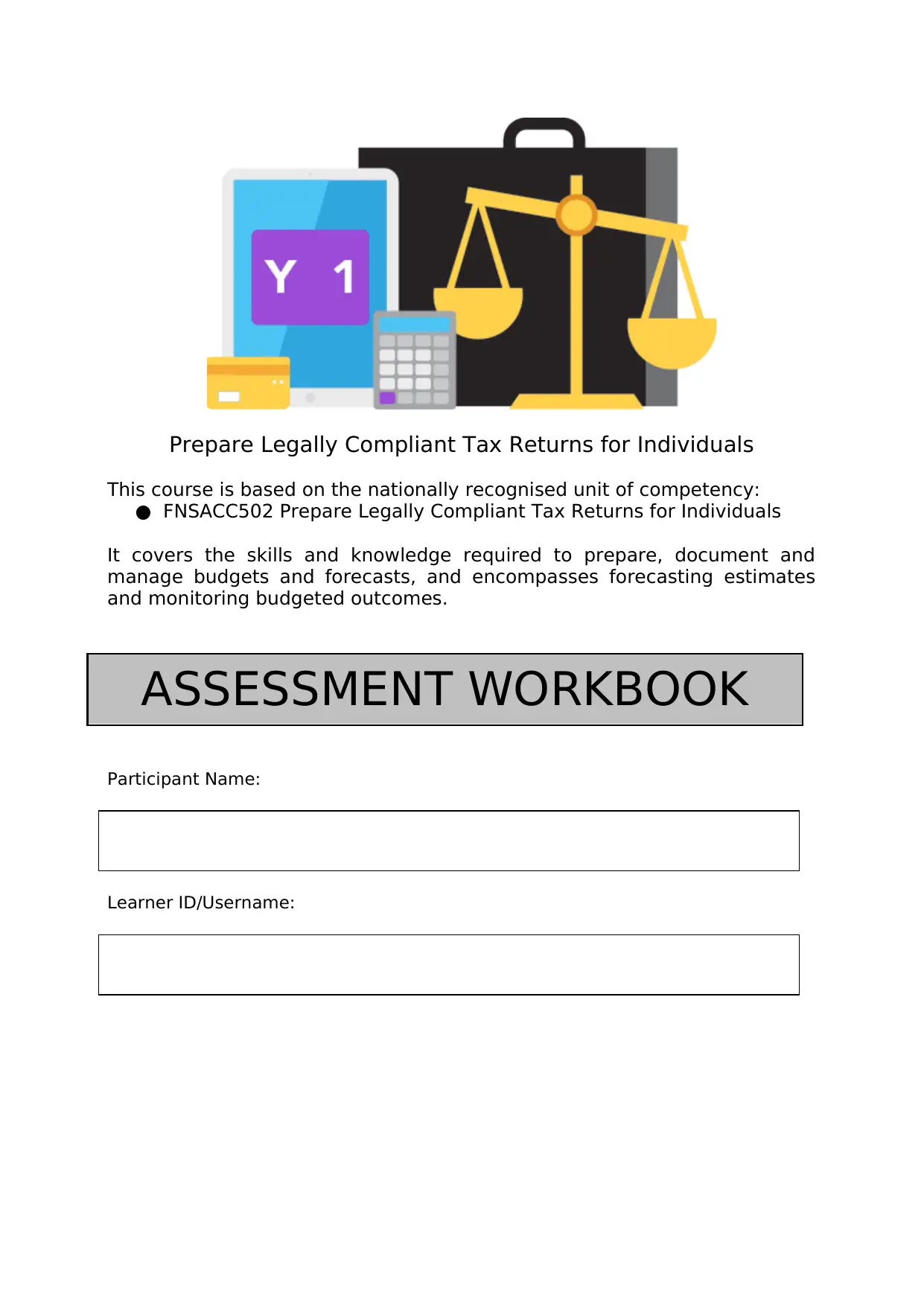
Prepare Legally Compliant Tax Returns for Individuals
This course is based on the nationally recognised unit of competency:
● FNSACC502 Prepare Legally Compliant Tax Returns for Individuals
It covers the skills and knowledge required to prepare, document and
manage budgets and forecasts, and encompasses forecasting estimates
and monitoring budgeted outcomes.
ASSESSMENT WORKBOOK
Participant Name:
Learner ID/Username:
This course is based on the nationally recognised unit of competency:
● FNSACC502 Prepare Legally Compliant Tax Returns for Individuals
It covers the skills and knowledge required to prepare, document and
manage budgets and forecasts, and encompasses forecasting estimates
and monitoring budgeted outcomes.
ASSESSMENT WORKBOOK
Participant Name:
Learner ID/Username:
Paraphrase This Document
Need a fresh take? Get an instant paraphrase of this document with our AI Paraphraser
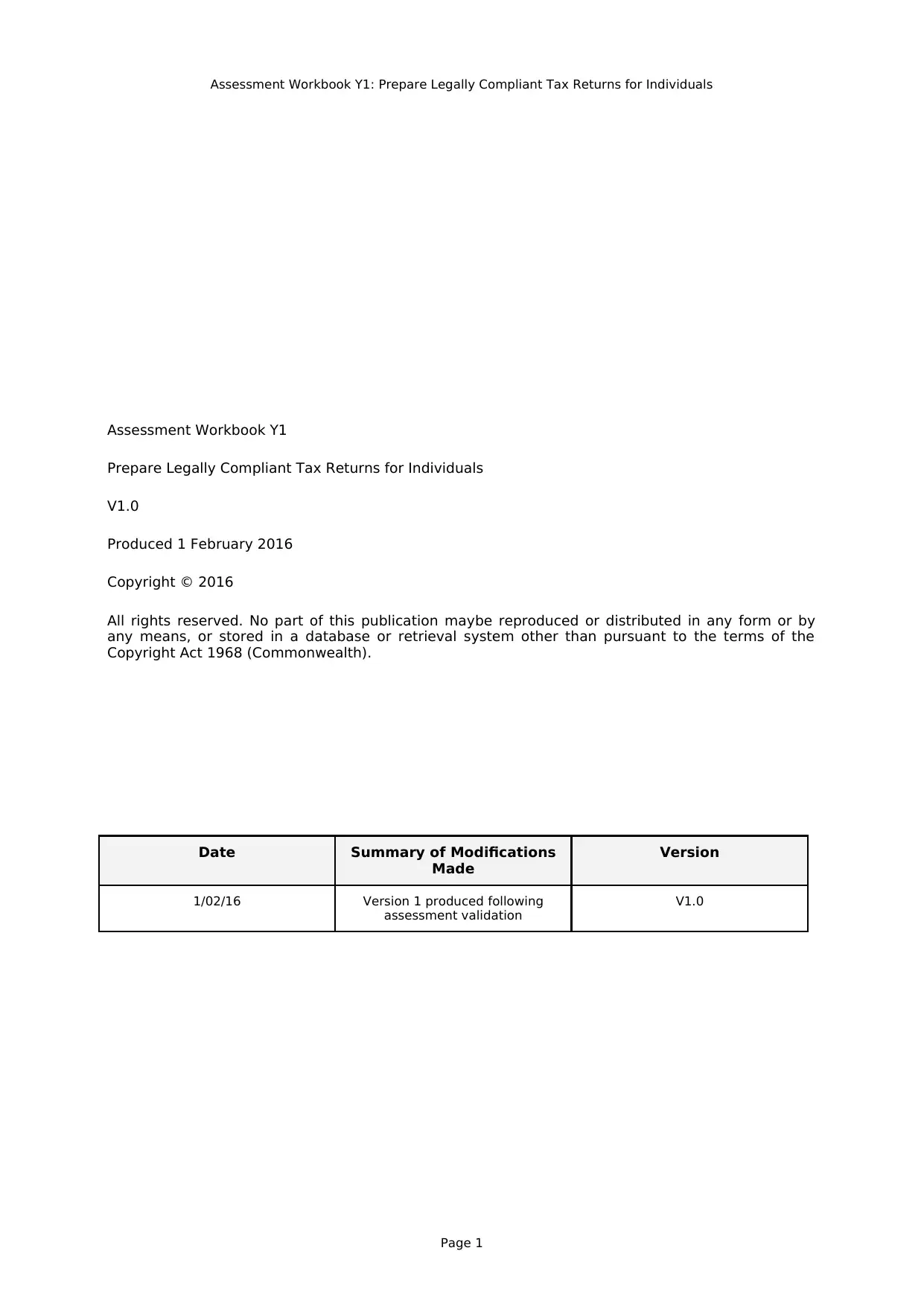
Assessment Workbook Y1: Prepare Legally Compliant Tax Returns for Individuals
Assessment Workbook Y1
Prepare Legally Compliant Tax Returns for Individuals
V1.0
Produced 1 February 2016
Copyright © 2016
All rights reserved. No part of this publication maybe reproduced or distributed in any form or by
any means, or stored in a database or retrieval system other than pursuant to the terms of the
Copyright Act 1968 (Commonwealth).
Date Summary of Modifications
Made
Version
1/02/16 Version 1 produced following
assessment validation
V1.0
Page 1
Assessment Workbook Y1
Prepare Legally Compliant Tax Returns for Individuals
V1.0
Produced 1 February 2016
Copyright © 2016
All rights reserved. No part of this publication maybe reproduced or distributed in any form or by
any means, or stored in a database or retrieval system other than pursuant to the terms of the
Copyright Act 1968 (Commonwealth).
Date Summary of Modifications
Made
Version
1/02/16 Version 1 produced following
assessment validation
V1.0
Page 1
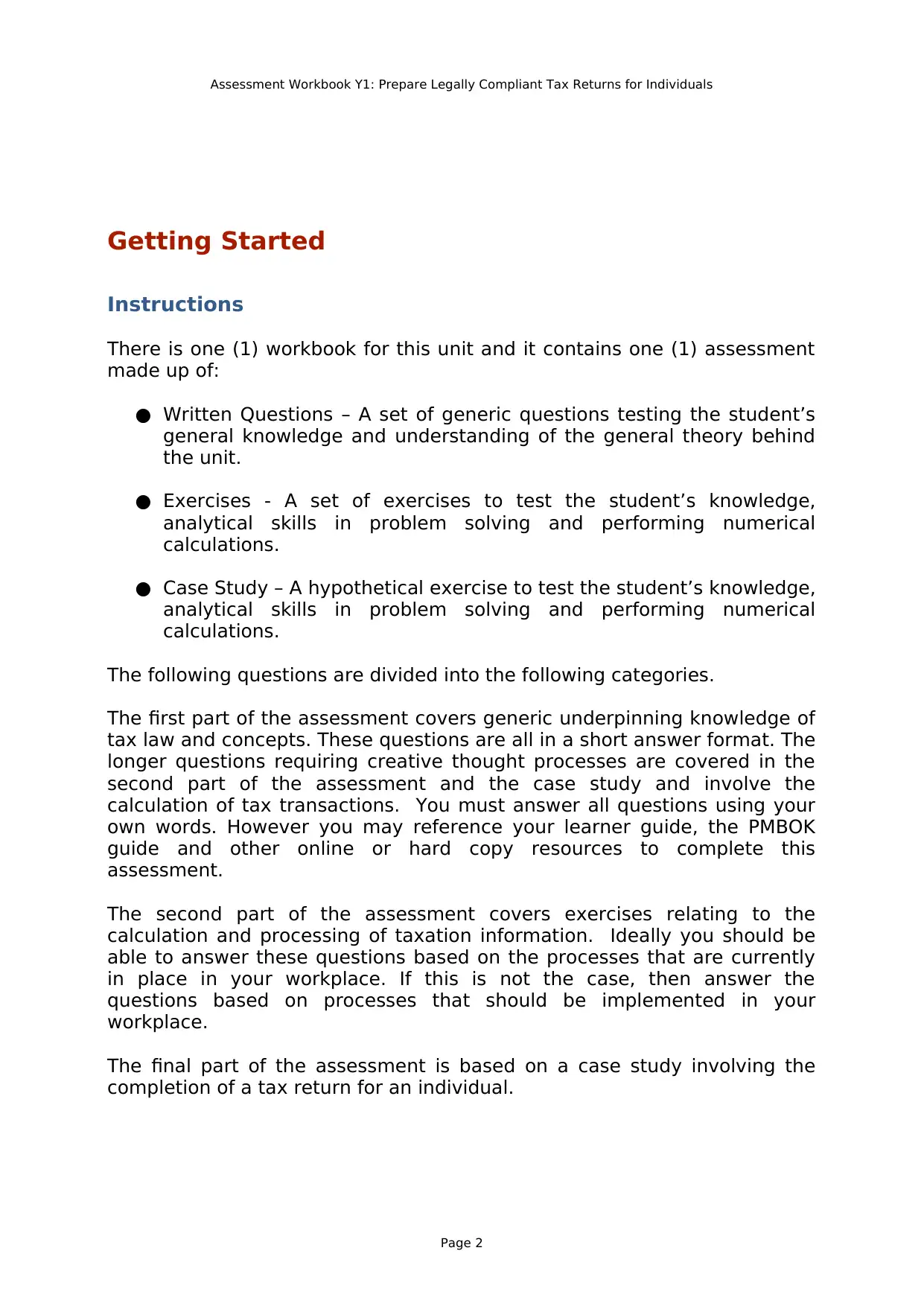
Assessment Workbook Y1: Prepare Legally Compliant Tax Returns for Individuals
Getting Started
Instructions
There is one (1) workbook for this unit and it contains one (1) assessment
made up of:
● Written Questions – A set of generic questions testing the student’s
general knowledge and understanding of the general theory behind
the unit.
● Exercises - A set of exercises to test the student’s knowledge,
analytical skills in problem solving and performing numerical
calculations.
● Case Study – A hypothetical exercise to test the student’s knowledge,
analytical skills in problem solving and performing numerical
calculations.
The following questions are divided into the following categories.
The first part of the assessment covers generic underpinning knowledge of
tax law and concepts. These questions are all in a short answer format. The
longer questions requiring creative thought processes are covered in the
second part of the assessment and the case study and involve the
calculation of tax transactions. You must answer all questions using your
own words. However you may reference your learner guide, the PMBOK
guide and other online or hard copy resources to complete this
assessment.
The second part of the assessment covers exercises relating to the
calculation and processing of taxation information. Ideally you should be
able to answer these questions based on the processes that are currently
in place in your workplace. If this is not the case, then answer the
questions based on processes that should be implemented in your
workplace.
The final part of the assessment is based on a case study involving the
completion of a tax return for an individual.
Page 2
Getting Started
Instructions
There is one (1) workbook for this unit and it contains one (1) assessment
made up of:
● Written Questions – A set of generic questions testing the student’s
general knowledge and understanding of the general theory behind
the unit.
● Exercises - A set of exercises to test the student’s knowledge,
analytical skills in problem solving and performing numerical
calculations.
● Case Study – A hypothetical exercise to test the student’s knowledge,
analytical skills in problem solving and performing numerical
calculations.
The following questions are divided into the following categories.
The first part of the assessment covers generic underpinning knowledge of
tax law and concepts. These questions are all in a short answer format. The
longer questions requiring creative thought processes are covered in the
second part of the assessment and the case study and involve the
calculation of tax transactions. You must answer all questions using your
own words. However you may reference your learner guide, the PMBOK
guide and other online or hard copy resources to complete this
assessment.
The second part of the assessment covers exercises relating to the
calculation and processing of taxation information. Ideally you should be
able to answer these questions based on the processes that are currently
in place in your workplace. If this is not the case, then answer the
questions based on processes that should be implemented in your
workplace.
The final part of the assessment is based on a case study involving the
completion of a tax return for an individual.
Page 2
⊘ This is a preview!⊘
Do you want full access?
Subscribe today to unlock all pages.

Trusted by 1+ million students worldwide
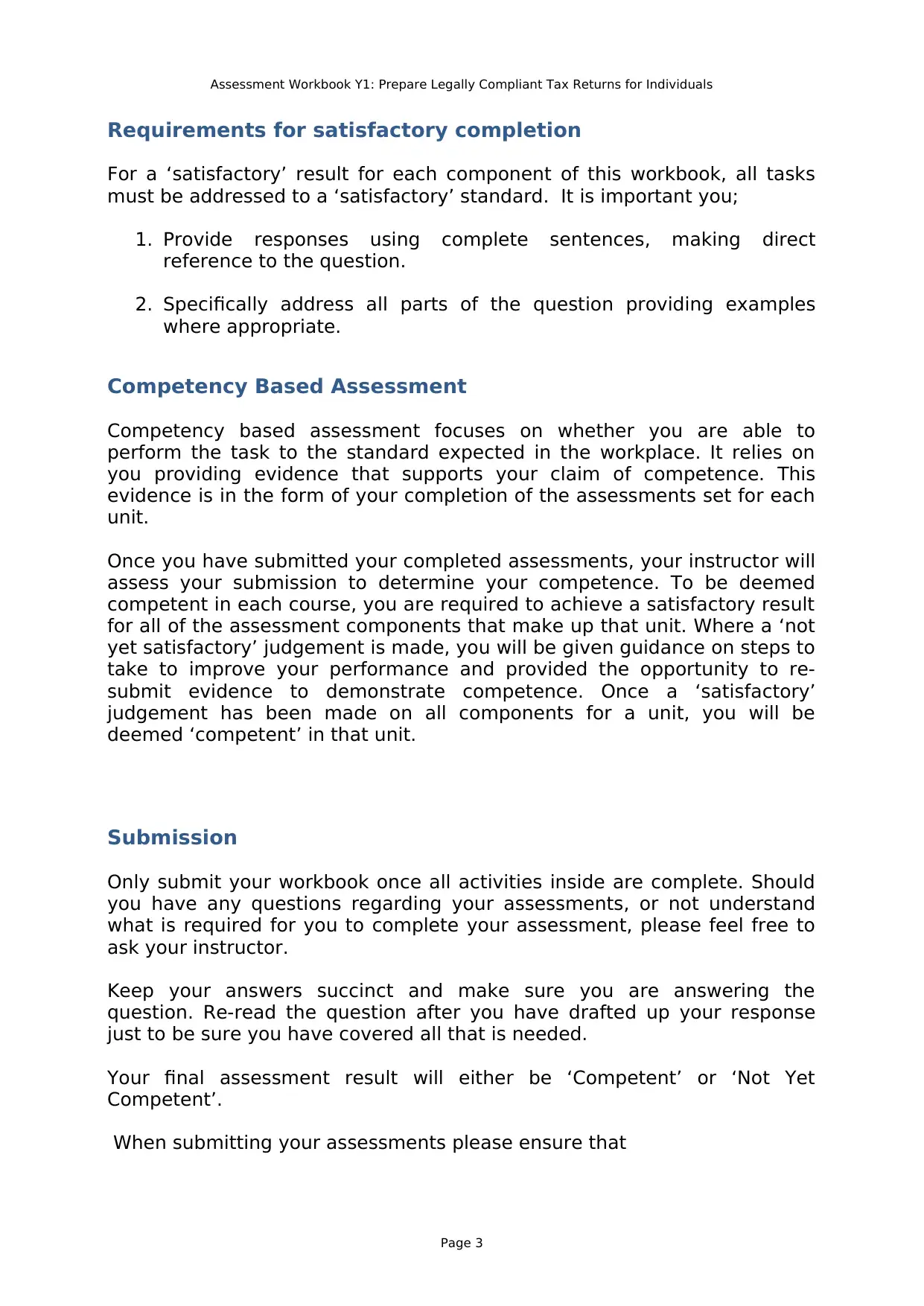
Assessment Workbook Y1: Prepare Legally Compliant Tax Returns for Individuals
Requirements for satisfactory completion
For a ‘satisfactory’ result for each component of this workbook, all tasks
must be addressed to a ‘satisfactory’ standard. It is important you;
1. Provide responses using complete sentences, making direct
reference to the question.
2. Specifically address all parts of the question providing examples
where appropriate.
Competency Based Assessment
Competency based assessment focuses on whether you are able to
perform the task to the standard expected in the workplace. It relies on
you providing evidence that supports your claim of competence. This
evidence is in the form of your completion of the assessments set for each
unit.
Once you have submitted your completed assessments, your instructor will
assess your submission to determine your competence. To be deemed
competent in each course, you are required to achieve a satisfactory result
for all of the assessment components that make up that unit. Where a ‘not
yet satisfactory’ judgement is made, you will be given guidance on steps to
take to improve your performance and provided the opportunity to re-
submit evidence to demonstrate competence. Once a ‘satisfactory’
judgement has been made on all components for a unit, you will be
deemed ‘competent’ in that unit.
Submission
Only submit your workbook once all activities inside are complete. Should
you have any questions regarding your assessments, or not understand
what is required for you to complete your assessment, please feel free to
ask your instructor.
Keep your answers succinct and make sure you are answering the
question. Re-read the question after you have drafted up your response
just to be sure you have covered all that is needed.
Your final assessment result will either be ‘Competent’ or ‘Not Yet
Competent’.
When submitting your assessments please ensure that
Page 3
Requirements for satisfactory completion
For a ‘satisfactory’ result for each component of this workbook, all tasks
must be addressed to a ‘satisfactory’ standard. It is important you;
1. Provide responses using complete sentences, making direct
reference to the question.
2. Specifically address all parts of the question providing examples
where appropriate.
Competency Based Assessment
Competency based assessment focuses on whether you are able to
perform the task to the standard expected in the workplace. It relies on
you providing evidence that supports your claim of competence. This
evidence is in the form of your completion of the assessments set for each
unit.
Once you have submitted your completed assessments, your instructor will
assess your submission to determine your competence. To be deemed
competent in each course, you are required to achieve a satisfactory result
for all of the assessment components that make up that unit. Where a ‘not
yet satisfactory’ judgement is made, you will be given guidance on steps to
take to improve your performance and provided the opportunity to re-
submit evidence to demonstrate competence. Once a ‘satisfactory’
judgement has been made on all components for a unit, you will be
deemed ‘competent’ in that unit.
Submission
Only submit your workbook once all activities inside are complete. Should
you have any questions regarding your assessments, or not understand
what is required for you to complete your assessment, please feel free to
ask your instructor.
Keep your answers succinct and make sure you are answering the
question. Re-read the question after you have drafted up your response
just to be sure you have covered all that is needed.
Your final assessment result will either be ‘Competent’ or ‘Not Yet
Competent’.
When submitting your assessments please ensure that
Page 3
Paraphrase This Document
Need a fresh take? Get an instant paraphrase of this document with our AI Paraphraser
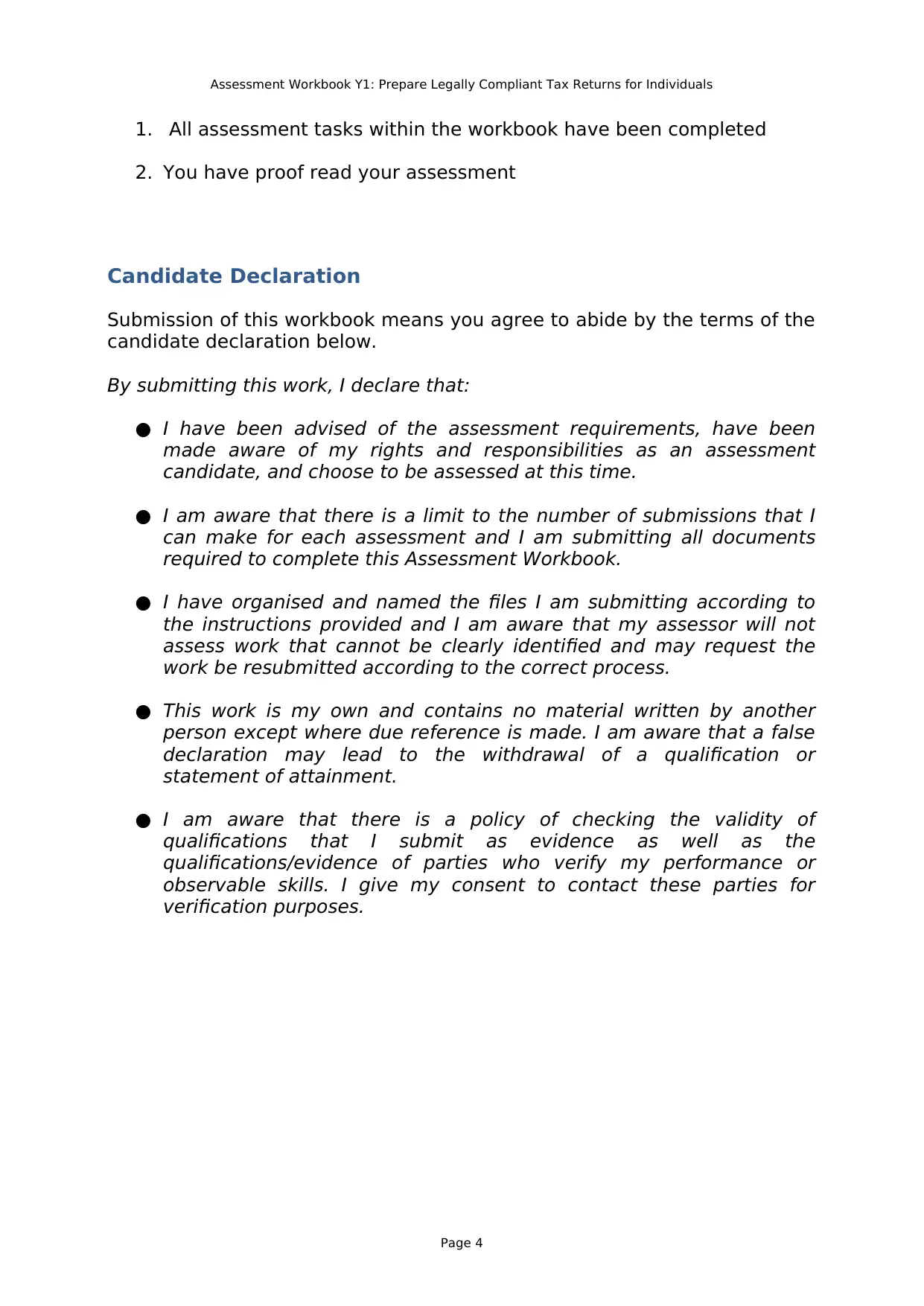
Assessment Workbook Y1: Prepare Legally Compliant Tax Returns for Individuals
1. All assessment tasks within the workbook have been completed
2. You have proof read your assessment
Candidate Declaration
Submission of this workbook means you agree to abide by the terms of the
candidate declaration below.
By submitting this work, I declare that:
● I have been advised of the assessment requirements, have been
made aware of my rights and responsibilities as an assessment
candidate, and choose to be assessed at this time.
● I am aware that there is a limit to the number of submissions that I
can make for each assessment and I am submitting all documents
required to complete this Assessment Workbook.
● I have organised and named the files I am submitting according to
the instructions provided and I am aware that my assessor will not
assess work that cannot be clearly identified and may request the
work be resubmitted according to the correct process.
● This work is my own and contains no material written by another
person except where due reference is made. I am aware that a false
declaration may lead to the withdrawal of a qualification or
statement of attainment.
● I am aware that there is a policy of checking the validity of
qualifications that I submit as evidence as well as the
qualifications/evidence of parties who verify my performance or
observable skills. I give my consent to contact these parties for
verification purposes.
Page 4
1. All assessment tasks within the workbook have been completed
2. You have proof read your assessment
Candidate Declaration
Submission of this workbook means you agree to abide by the terms of the
candidate declaration below.
By submitting this work, I declare that:
● I have been advised of the assessment requirements, have been
made aware of my rights and responsibilities as an assessment
candidate, and choose to be assessed at this time.
● I am aware that there is a limit to the number of submissions that I
can make for each assessment and I am submitting all documents
required to complete this Assessment Workbook.
● I have organised and named the files I am submitting according to
the instructions provided and I am aware that my assessor will not
assess work that cannot be clearly identified and may request the
work be resubmitted according to the correct process.
● This work is my own and contains no material written by another
person except where due reference is made. I am aware that a false
declaration may lead to the withdrawal of a qualification or
statement of attainment.
● I am aware that there is a policy of checking the validity of
qualifications that I submit as evidence as well as the
qualifications/evidence of parties who verify my performance or
observable skills. I give my consent to contact these parties for
verification purposes.
Page 4
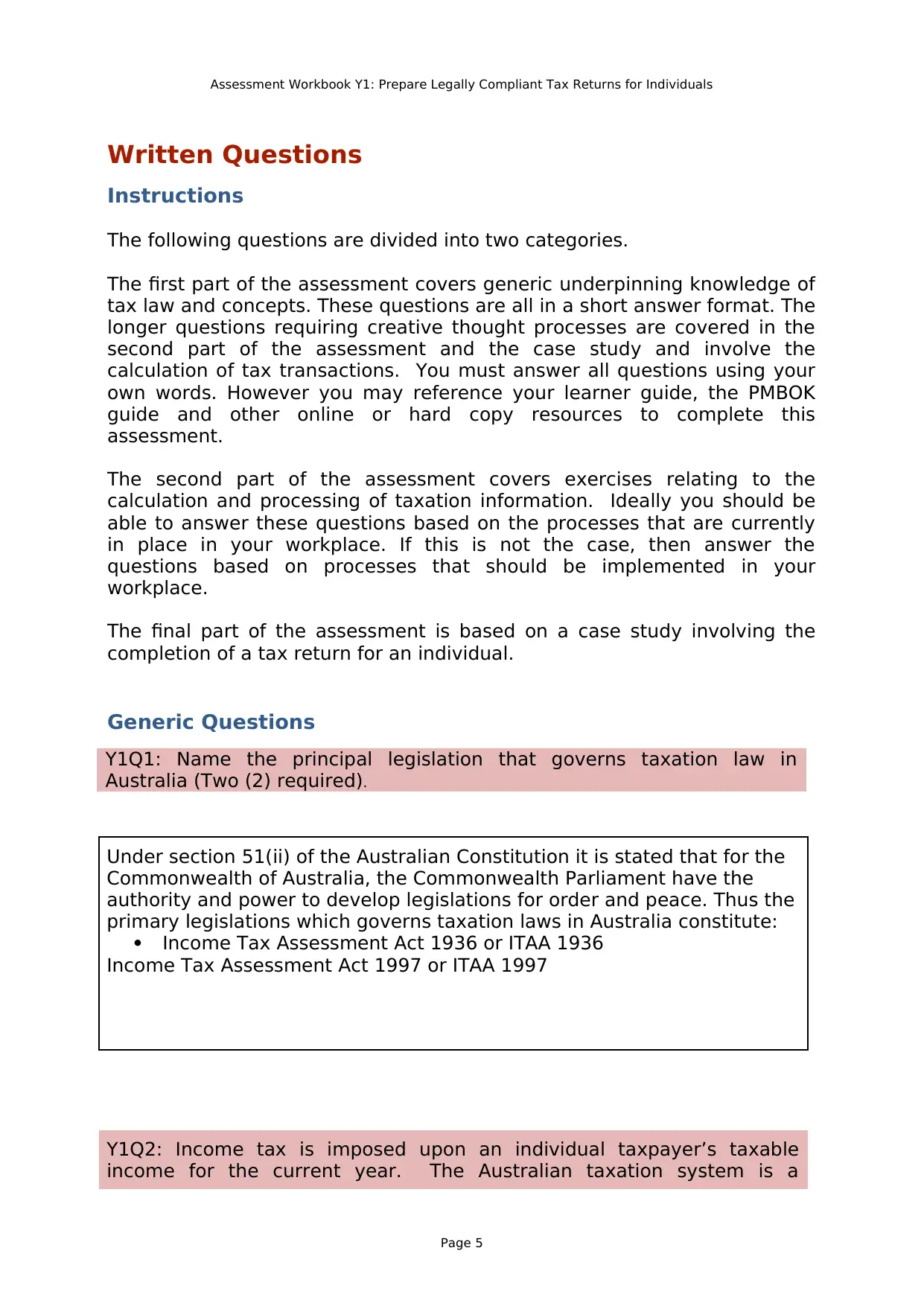
Assessment Workbook Y1: Prepare Legally Compliant Tax Returns for Individuals
Written Questions
Instructions
The following questions are divided into two categories.
The first part of the assessment covers generic underpinning knowledge of
tax law and concepts. These questions are all in a short answer format. The
longer questions requiring creative thought processes are covered in the
second part of the assessment and the case study and involve the
calculation of tax transactions. You must answer all questions using your
own words. However you may reference your learner guide, the PMBOK
guide and other online or hard copy resources to complete this
assessment.
The second part of the assessment covers exercises relating to the
calculation and processing of taxation information. Ideally you should be
able to answer these questions based on the processes that are currently
in place in your workplace. If this is not the case, then answer the
questions based on processes that should be implemented in your
workplace.
The final part of the assessment is based on a case study involving the
completion of a tax return for an individual.
Generic Questions
Y1Q1: Name the principal legislation that governs taxation law in
Australia (Two (2) required).
Under section 51(ii) of the Australian Constitution it is stated that for the
Commonwealth of Australia, the Commonwealth Parliament have the
authority and power to develop legislations for order and peace. Thus the
primary legislations which governs taxation laws in Australia constitute:
Income Tax Assessment Act 1936 or ITAA 1936
Income Tax Assessment Act 1997 or ITAA 1997
Y1Q2: Income tax is imposed upon an individual taxpayer’s taxable
income for the current year. The Australian taxation system is a
Page 5
Written Questions
Instructions
The following questions are divided into two categories.
The first part of the assessment covers generic underpinning knowledge of
tax law and concepts. These questions are all in a short answer format. The
longer questions requiring creative thought processes are covered in the
second part of the assessment and the case study and involve the
calculation of tax transactions. You must answer all questions using your
own words. However you may reference your learner guide, the PMBOK
guide and other online or hard copy resources to complete this
assessment.
The second part of the assessment covers exercises relating to the
calculation and processing of taxation information. Ideally you should be
able to answer these questions based on the processes that are currently
in place in your workplace. If this is not the case, then answer the
questions based on processes that should be implemented in your
workplace.
The final part of the assessment is based on a case study involving the
completion of a tax return for an individual.
Generic Questions
Y1Q1: Name the principal legislation that governs taxation law in
Australia (Two (2) required).
Under section 51(ii) of the Australian Constitution it is stated that for the
Commonwealth of Australia, the Commonwealth Parliament have the
authority and power to develop legislations for order and peace. Thus the
primary legislations which governs taxation laws in Australia constitute:
Income Tax Assessment Act 1936 or ITAA 1936
Income Tax Assessment Act 1997 or ITAA 1997
Y1Q2: Income tax is imposed upon an individual taxpayer’s taxable
income for the current year. The Australian taxation system is a
Page 5
⊘ This is a preview!⊘
Do you want full access?
Subscribe today to unlock all pages.

Trusted by 1+ million students worldwide
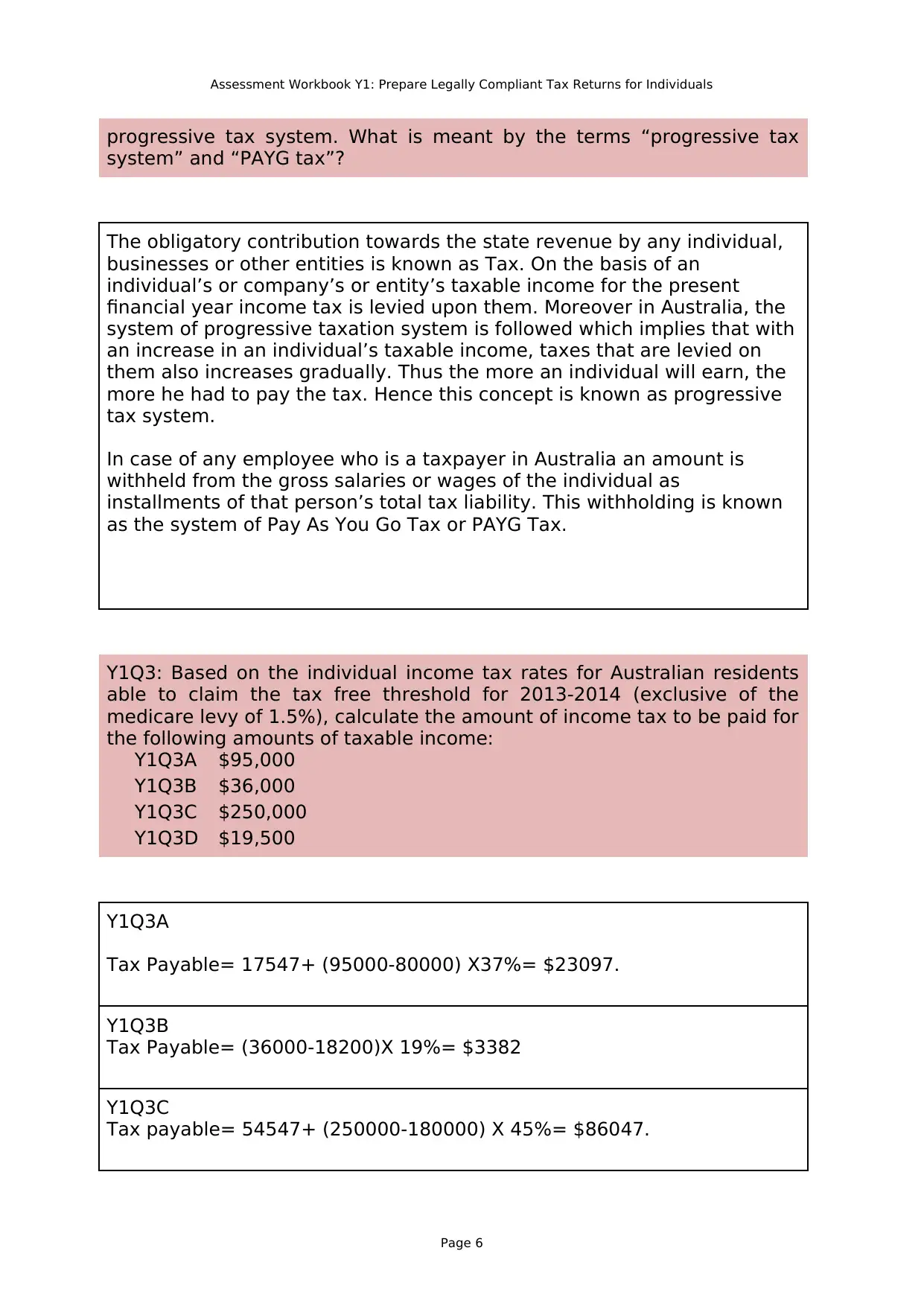
Assessment Workbook Y1: Prepare Legally Compliant Tax Returns for Individuals
progressive tax system. What is meant by the terms “progressive tax
system” and “PAYG tax”?
The obligatory contribution towards the state revenue by any individual,
businesses or other entities is known as Tax. On the basis of an
individual’s or company’s or entity’s taxable income for the present
financial year income tax is levied upon them. Moreover in Australia, the
system of progressive taxation system is followed which implies that with
an increase in an individual’s taxable income, taxes that are levied on
them also increases gradually. Thus the more an individual will earn, the
more he had to pay the tax. Hence this concept is known as progressive
tax system.
In case of any employee who is a taxpayer in Australia an amount is
withheld from the gross salaries or wages of the individual as
installments of that person’s total tax liability. This withholding is known
as the system of Pay As You Go Tax or PAYG Tax.
Y1Q3: Based on the individual income tax rates for Australian residents
able to claim the tax free threshold for 2013-2014 (exclusive of the
medicare levy of 1.5%), calculate the amount of income tax to be paid for
the following amounts of taxable income:
Y1Q3A $95,000
Y1Q3B $36,000
Y1Q3C $250,000
Y1Q3D $19,500
Y1Q3A
Tax Payable= 17547+ (95000-80000) X37%= $23097.
Y1Q3B
Tax Payable= (36000-18200)X 19%= $3382
Y1Q3C
Tax payable= 54547+ (250000-180000) X 45%= $86047.
Page 6
progressive tax system. What is meant by the terms “progressive tax
system” and “PAYG tax”?
The obligatory contribution towards the state revenue by any individual,
businesses or other entities is known as Tax. On the basis of an
individual’s or company’s or entity’s taxable income for the present
financial year income tax is levied upon them. Moreover in Australia, the
system of progressive taxation system is followed which implies that with
an increase in an individual’s taxable income, taxes that are levied on
them also increases gradually. Thus the more an individual will earn, the
more he had to pay the tax. Hence this concept is known as progressive
tax system.
In case of any employee who is a taxpayer in Australia an amount is
withheld from the gross salaries or wages of the individual as
installments of that person’s total tax liability. This withholding is known
as the system of Pay As You Go Tax or PAYG Tax.
Y1Q3: Based on the individual income tax rates for Australian residents
able to claim the tax free threshold for 2013-2014 (exclusive of the
medicare levy of 1.5%), calculate the amount of income tax to be paid for
the following amounts of taxable income:
Y1Q3A $95,000
Y1Q3B $36,000
Y1Q3C $250,000
Y1Q3D $19,500
Y1Q3A
Tax Payable= 17547+ (95000-80000) X37%= $23097.
Y1Q3B
Tax Payable= (36000-18200)X 19%= $3382
Y1Q3C
Tax payable= 54547+ (250000-180000) X 45%= $86047.
Page 6
Paraphrase This Document
Need a fresh take? Get an instant paraphrase of this document with our AI Paraphraser
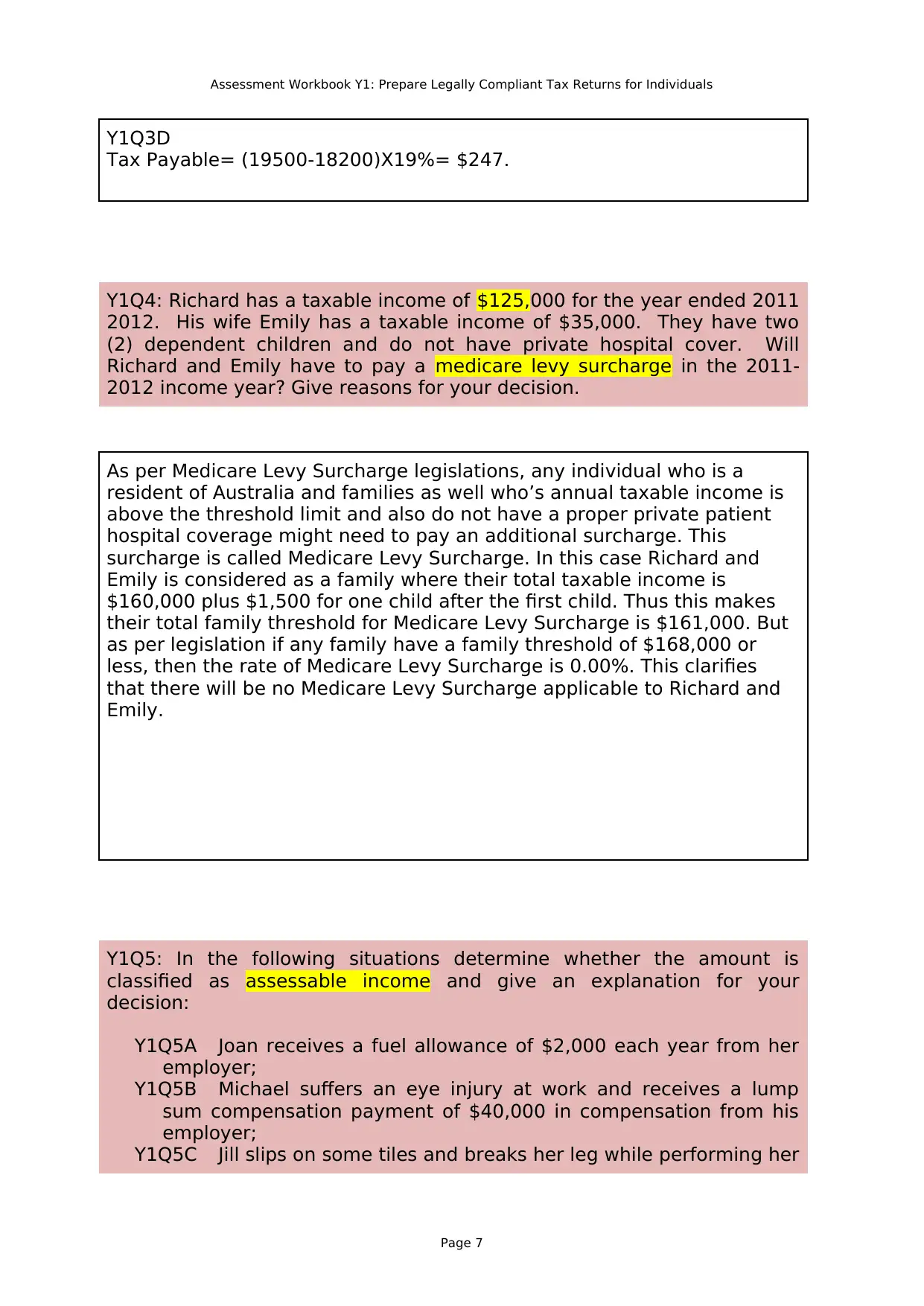
Assessment Workbook Y1: Prepare Legally Compliant Tax Returns for Individuals
Y1Q3D
Tax Payable= (19500-18200)X19%= $247.
Y1Q4: Richard has a taxable income of $125,000 for the year ended 2011
2012. His wife Emily has a taxable income of $35,000. They have two
(2) dependent children and do not have private hospital cover. Will
Richard and Emily have to pay a medicare levy surcharge in the 2011-
2012 income year? Give reasons for your decision.
As per Medicare Levy Surcharge legislations, any individual who is a
resident of Australia and families as well who’s annual taxable income is
above the threshold limit and also do not have a proper private patient
hospital coverage might need to pay an additional surcharge. This
surcharge is called Medicare Levy Surcharge. In this case Richard and
Emily is considered as a family where their total taxable income is
$160,000 plus $1,500 for one child after the first child. Thus this makes
their total family threshold for Medicare Levy Surcharge is $161,000. But
as per legislation if any family have a family threshold of $168,000 or
less, then the rate of Medicare Levy Surcharge is 0.00%. This clarifies
that there will be no Medicare Levy Surcharge applicable to Richard and
Emily.
Y1Q5: In the following situations determine whether the amount is
classified as assessable income and give an explanation for your
decision:
Y1Q5A Joan receives a fuel allowance of $2,000 each year from her
employer;
Y1Q5B Michael suffers an eye injury at work and receives a lump
sum compensation payment of $40,000 in compensation from his
employer;
Y1Q5C Jill slips on some tiles and breaks her leg while performing her
Page 7
Y1Q3D
Tax Payable= (19500-18200)X19%= $247.
Y1Q4: Richard has a taxable income of $125,000 for the year ended 2011
2012. His wife Emily has a taxable income of $35,000. They have two
(2) dependent children and do not have private hospital cover. Will
Richard and Emily have to pay a medicare levy surcharge in the 2011-
2012 income year? Give reasons for your decision.
As per Medicare Levy Surcharge legislations, any individual who is a
resident of Australia and families as well who’s annual taxable income is
above the threshold limit and also do not have a proper private patient
hospital coverage might need to pay an additional surcharge. This
surcharge is called Medicare Levy Surcharge. In this case Richard and
Emily is considered as a family where their total taxable income is
$160,000 plus $1,500 for one child after the first child. Thus this makes
their total family threshold for Medicare Levy Surcharge is $161,000. But
as per legislation if any family have a family threshold of $168,000 or
less, then the rate of Medicare Levy Surcharge is 0.00%. This clarifies
that there will be no Medicare Levy Surcharge applicable to Richard and
Emily.
Y1Q5: In the following situations determine whether the amount is
classified as assessable income and give an explanation for your
decision:
Y1Q5A Joan receives a fuel allowance of $2,000 each year from her
employer;
Y1Q5B Michael suffers an eye injury at work and receives a lump
sum compensation payment of $40,000 in compensation from his
employer;
Y1Q5C Jill slips on some tiles and breaks her leg while performing her
Page 7
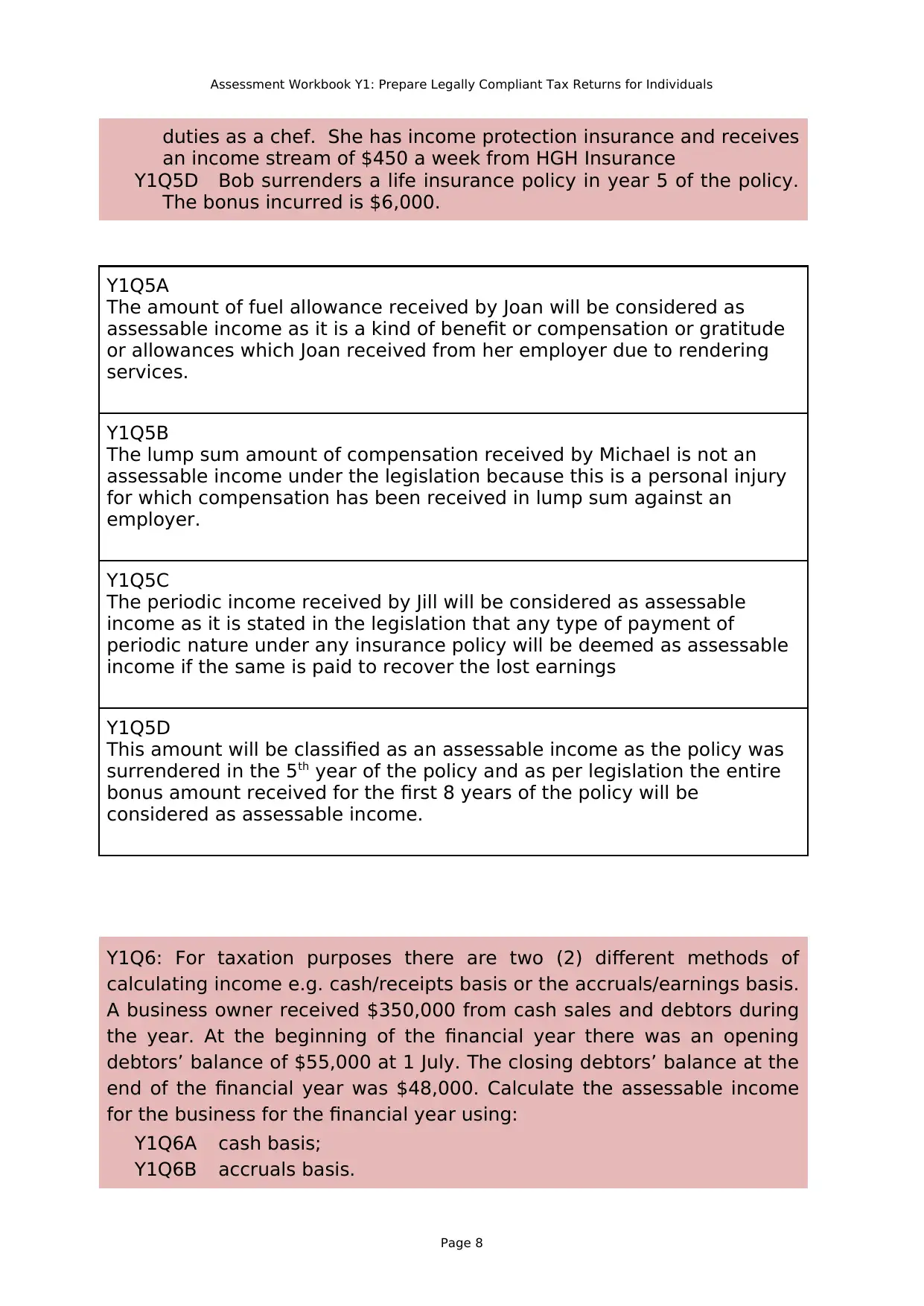
Assessment Workbook Y1: Prepare Legally Compliant Tax Returns for Individuals
duties as a chef. She has income protection insurance and receives
an income stream of $450 a week from HGH Insurance
Y1Q5D Bob surrenders a life insurance policy in year 5 of the policy.
The bonus incurred is $6,000.
Y1Q5A
The amount of fuel allowance received by Joan will be considered as
assessable income as it is a kind of benefit or compensation or gratitude
or allowances which Joan received from her employer due to rendering
services.
Y1Q5B
The lump sum amount of compensation received by Michael is not an
assessable income under the legislation because this is a personal injury
for which compensation has been received in lump sum against an
employer.
Y1Q5C
The periodic income received by Jill will be considered as assessable
income as it is stated in the legislation that any type of payment of
periodic nature under any insurance policy will be deemed as assessable
income if the same is paid to recover the lost earnings
Y1Q5D
This amount will be classified as an assessable income as the policy was
surrendered in the 5th year of the policy and as per legislation the entire
bonus amount received for the first 8 years of the policy will be
considered as assessable income.
Y1Q6: For taxation purposes there are two (2) different methods of
calculating income e.g. cash/receipts basis or the accruals/earnings basis.
A business owner received $350,000 from cash sales and debtors during
the year. At the beginning of the financial year there was an opening
debtors’ balance of $55,000 at 1 July. The closing debtors’ balance at the
end of the financial year was $48,000. Calculate the assessable income
for the business for the financial year using:
Y1Q6A cash basis;
Y1Q6B accruals basis.
Page 8
duties as a chef. She has income protection insurance and receives
an income stream of $450 a week from HGH Insurance
Y1Q5D Bob surrenders a life insurance policy in year 5 of the policy.
The bonus incurred is $6,000.
Y1Q5A
The amount of fuel allowance received by Joan will be considered as
assessable income as it is a kind of benefit or compensation or gratitude
or allowances which Joan received from her employer due to rendering
services.
Y1Q5B
The lump sum amount of compensation received by Michael is not an
assessable income under the legislation because this is a personal injury
for which compensation has been received in lump sum against an
employer.
Y1Q5C
The periodic income received by Jill will be considered as assessable
income as it is stated in the legislation that any type of payment of
periodic nature under any insurance policy will be deemed as assessable
income if the same is paid to recover the lost earnings
Y1Q5D
This amount will be classified as an assessable income as the policy was
surrendered in the 5th year of the policy and as per legislation the entire
bonus amount received for the first 8 years of the policy will be
considered as assessable income.
Y1Q6: For taxation purposes there are two (2) different methods of
calculating income e.g. cash/receipts basis or the accruals/earnings basis.
A business owner received $350,000 from cash sales and debtors during
the year. At the beginning of the financial year there was an opening
debtors’ balance of $55,000 at 1 July. The closing debtors’ balance at the
end of the financial year was $48,000. Calculate the assessable income
for the business for the financial year using:
Y1Q6A cash basis;
Y1Q6B accruals basis.
Page 8
⊘ This is a preview!⊘
Do you want full access?
Subscribe today to unlock all pages.

Trusted by 1+ million students worldwide
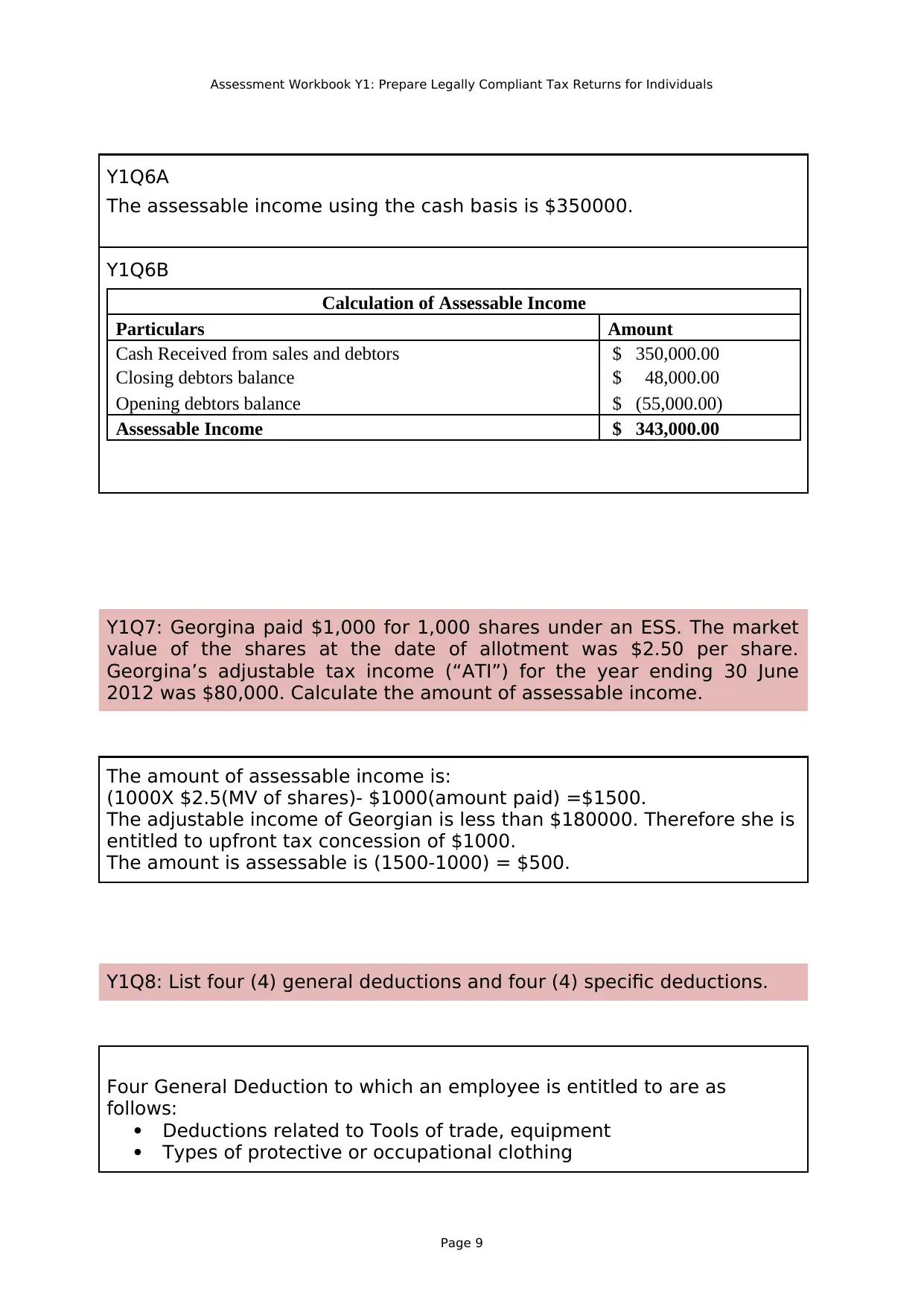
Assessment Workbook Y1: Prepare Legally Compliant Tax Returns for Individuals
Y1Q6A
The assessable income using the cash basis is $350000.
Y1Q6B
Calculation of Assessable Income
Particulars Amount
Cash Received from sales and debtors $ 350,000.00
Closing debtors balance $ 48,000.00
Opening debtors balance $ (55,000.00)
Assessable Income $ 343,000.00
Y1Q7: Georgina paid $1,000 for 1,000 shares under an ESS. The market
value of the shares at the date of allotment was $2.50 per share.
Georgina’s adjustable tax income (“ATI”) for the year ending 30 June
2012 was $80,000. Calculate the amount of assessable income.
The amount of assessable income is:
(1000X $2.5(MV of shares)- $1000(amount paid) =$1500.
The adjustable income of Georgian is less than $180000. Therefore she is
entitled to upfront tax concession of $1000.
The amount is assessable is (1500-1000) = $500.
Y1Q8: List four (4) general deductions and four (4) specific deductions.
Four General Deduction to which an employee is entitled to are as
follows:
Deductions related to Tools of trade, equipment
Types of protective or occupational clothing
Page 9
Y1Q6A
The assessable income using the cash basis is $350000.
Y1Q6B
Calculation of Assessable Income
Particulars Amount
Cash Received from sales and debtors $ 350,000.00
Closing debtors balance $ 48,000.00
Opening debtors balance $ (55,000.00)
Assessable Income $ 343,000.00
Y1Q7: Georgina paid $1,000 for 1,000 shares under an ESS. The market
value of the shares at the date of allotment was $2.50 per share.
Georgina’s adjustable tax income (“ATI”) for the year ending 30 June
2012 was $80,000. Calculate the amount of assessable income.
The amount of assessable income is:
(1000X $2.5(MV of shares)- $1000(amount paid) =$1500.
The adjustable income of Georgian is less than $180000. Therefore she is
entitled to upfront tax concession of $1000.
The amount is assessable is (1500-1000) = $500.
Y1Q8: List four (4) general deductions and four (4) specific deductions.
Four General Deduction to which an employee is entitled to are as
follows:
Deductions related to Tools of trade, equipment
Types of protective or occupational clothing
Page 9
Paraphrase This Document
Need a fresh take? Get an instant paraphrase of this document with our AI Paraphraser
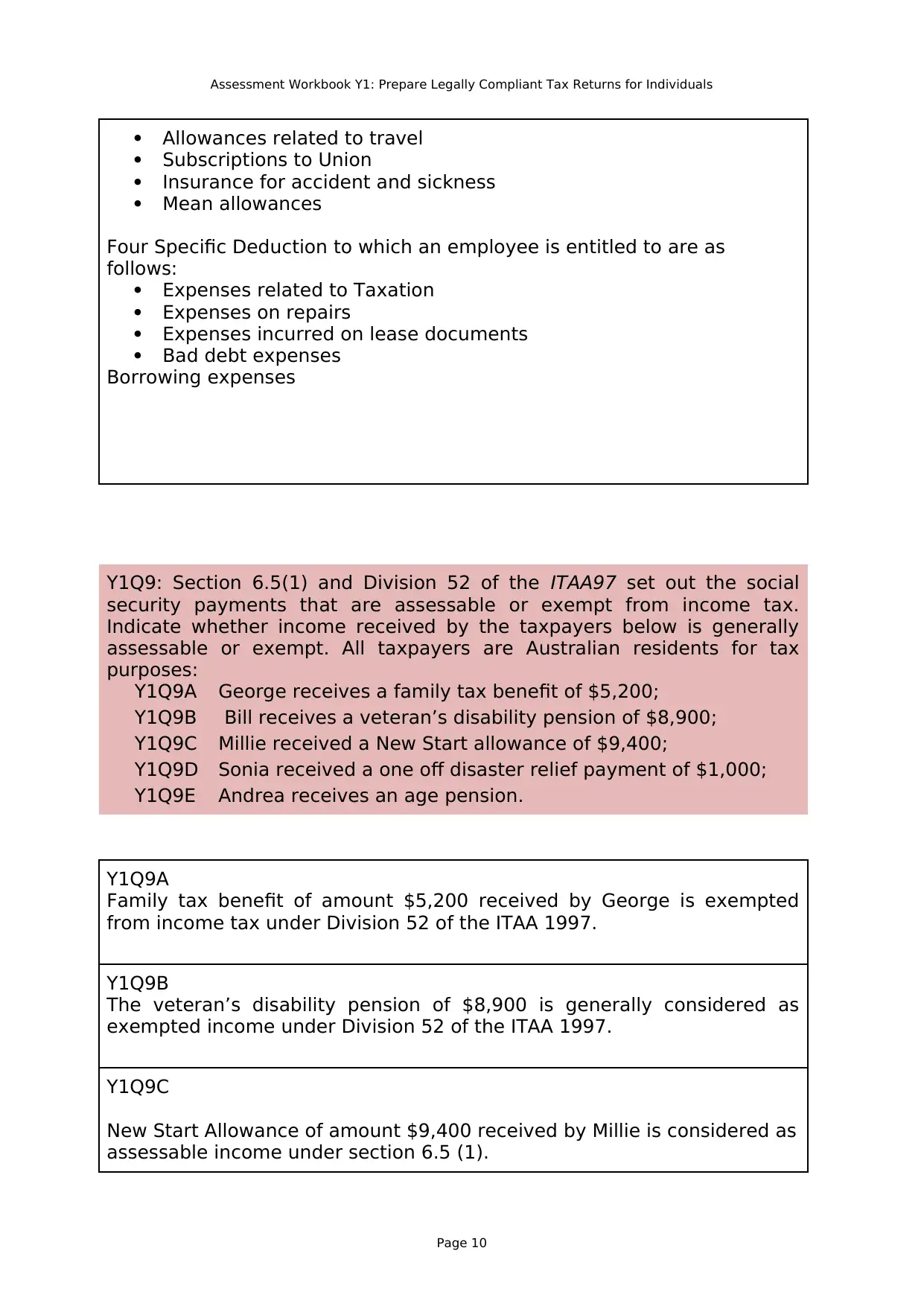
Assessment Workbook Y1: Prepare Legally Compliant Tax Returns for Individuals
Allowances related to travel
Subscriptions to Union
Insurance for accident and sickness
Mean allowances
Four Specific Deduction to which an employee is entitled to are as
follows:
Expenses related to Taxation
Expenses on repairs
Expenses incurred on lease documents
Bad debt expenses
Borrowing expenses
Y1Q9: Section 6.5(1) and Division 52 of the ITAA97 set out the social
security payments that are assessable or exempt from income tax.
Indicate whether income received by the taxpayers below is generally
assessable or exempt. All taxpayers are Australian residents for tax
purposes:
Y1Q9A George receives a family tax benefit of $5,200;
Y1Q9B Bill receives a veteran’s disability pension of $8,900;
Y1Q9C Millie received a New Start allowance of $9,400;
Y1Q9D Sonia received a one off disaster relief payment of $1,000;
Y1Q9E Andrea receives an age pension.
Y1Q9A
Family tax benefit of amount $5,200 received by George is exempted
from income tax under Division 52 of the ITAA 1997.
Y1Q9B
The veteran’s disability pension of $8,900 is generally considered as
exempted income under Division 52 of the ITAA 1997.
Y1Q9C
New Start Allowance of amount $9,400 received by Millie is considered as
assessable income under section 6.5 (1).
Page 10
Allowances related to travel
Subscriptions to Union
Insurance for accident and sickness
Mean allowances
Four Specific Deduction to which an employee is entitled to are as
follows:
Expenses related to Taxation
Expenses on repairs
Expenses incurred on lease documents
Bad debt expenses
Borrowing expenses
Y1Q9: Section 6.5(1) and Division 52 of the ITAA97 set out the social
security payments that are assessable or exempt from income tax.
Indicate whether income received by the taxpayers below is generally
assessable or exempt. All taxpayers are Australian residents for tax
purposes:
Y1Q9A George receives a family tax benefit of $5,200;
Y1Q9B Bill receives a veteran’s disability pension of $8,900;
Y1Q9C Millie received a New Start allowance of $9,400;
Y1Q9D Sonia received a one off disaster relief payment of $1,000;
Y1Q9E Andrea receives an age pension.
Y1Q9A
Family tax benefit of amount $5,200 received by George is exempted
from income tax under Division 52 of the ITAA 1997.
Y1Q9B
The veteran’s disability pension of $8,900 is generally considered as
exempted income under Division 52 of the ITAA 1997.
Y1Q9C
New Start Allowance of amount $9,400 received by Millie is considered as
assessable income under section 6.5 (1).
Page 10
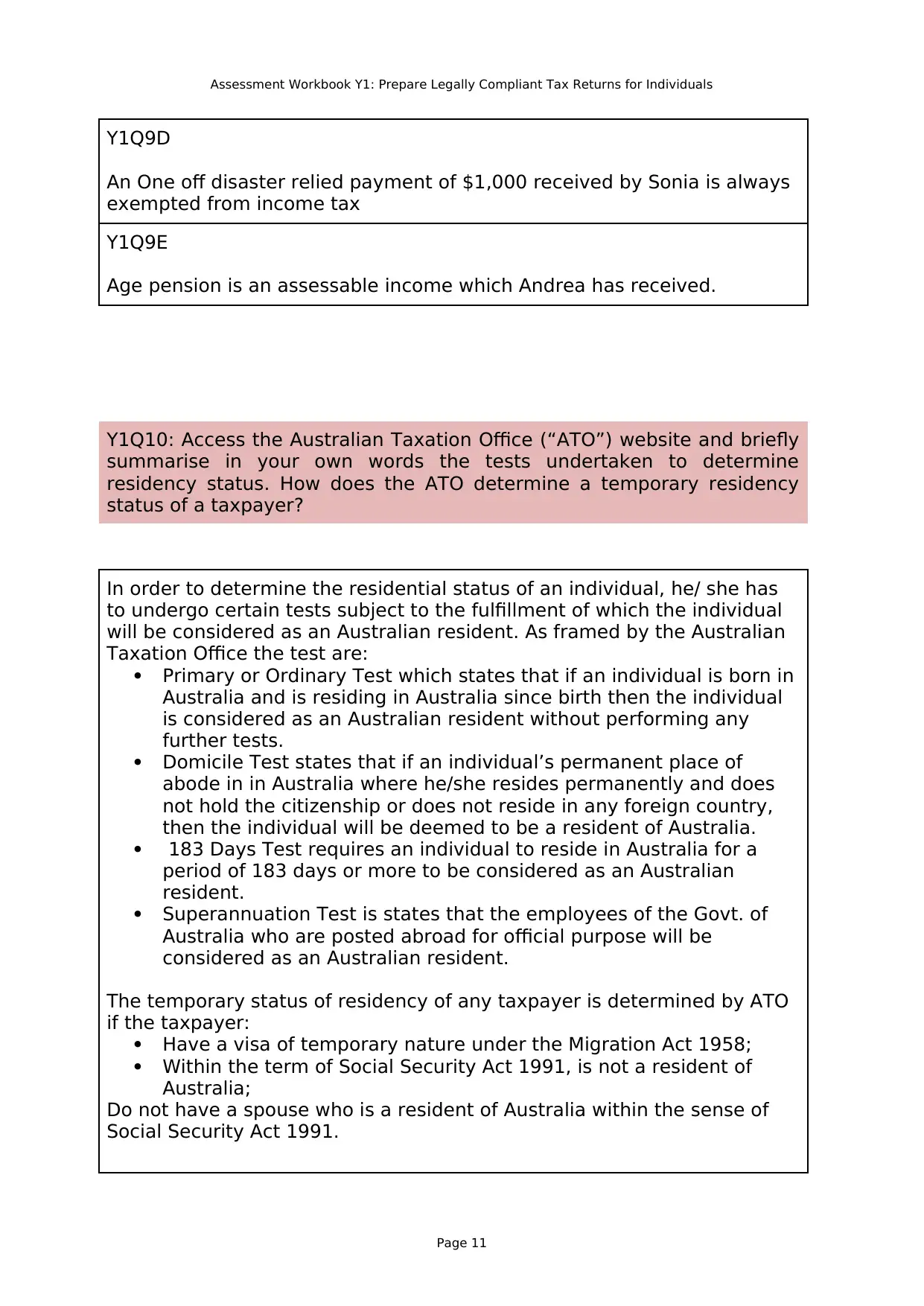
Assessment Workbook Y1: Prepare Legally Compliant Tax Returns for Individuals
Y1Q9D
An One off disaster relied payment of $1,000 received by Sonia is always
exempted from income tax
Y1Q9E
Age pension is an assessable income which Andrea has received.
Y1Q10: Access the Australian Taxation Office (“ATO”) website and briefly
summarise in your own words the tests undertaken to determine
residency status. How does the ATO determine a temporary residency
status of a taxpayer?
In order to determine the residential status of an individual, he/ she has
to undergo certain tests subject to the fulfillment of which the individual
will be considered as an Australian resident. As framed by the Australian
Taxation Office the test are:
Primary or Ordinary Test which states that if an individual is born in
Australia and is residing in Australia since birth then the individual
is considered as an Australian resident without performing any
further tests.
Domicile Test states that if an individual’s permanent place of
abode in in Australia where he/she resides permanently and does
not hold the citizenship or does not reside in any foreign country,
then the individual will be deemed to be a resident of Australia.
183 Days Test requires an individual to reside in Australia for a
period of 183 days or more to be considered as an Australian
resident.
Superannuation Test is states that the employees of the Govt. of
Australia who are posted abroad for official purpose will be
considered as an Australian resident.
The temporary status of residency of any taxpayer is determined by ATO
if the taxpayer:
Have a visa of temporary nature under the Migration Act 1958;
Within the term of Social Security Act 1991, is not a resident of
Australia;
Do not have a spouse who is a resident of Australia within the sense of
Social Security Act 1991.
Page 11
Y1Q9D
An One off disaster relied payment of $1,000 received by Sonia is always
exempted from income tax
Y1Q9E
Age pension is an assessable income which Andrea has received.
Y1Q10: Access the Australian Taxation Office (“ATO”) website and briefly
summarise in your own words the tests undertaken to determine
residency status. How does the ATO determine a temporary residency
status of a taxpayer?
In order to determine the residential status of an individual, he/ she has
to undergo certain tests subject to the fulfillment of which the individual
will be considered as an Australian resident. As framed by the Australian
Taxation Office the test are:
Primary or Ordinary Test which states that if an individual is born in
Australia and is residing in Australia since birth then the individual
is considered as an Australian resident without performing any
further tests.
Domicile Test states that if an individual’s permanent place of
abode in in Australia where he/she resides permanently and does
not hold the citizenship or does not reside in any foreign country,
then the individual will be deemed to be a resident of Australia.
183 Days Test requires an individual to reside in Australia for a
period of 183 days or more to be considered as an Australian
resident.
Superannuation Test is states that the employees of the Govt. of
Australia who are posted abroad for official purpose will be
considered as an Australian resident.
The temporary status of residency of any taxpayer is determined by ATO
if the taxpayer:
Have a visa of temporary nature under the Migration Act 1958;
Within the term of Social Security Act 1991, is not a resident of
Australia;
Do not have a spouse who is a resident of Australia within the sense of
Social Security Act 1991.
Page 11
⊘ This is a preview!⊘
Do you want full access?
Subscribe today to unlock all pages.

Trusted by 1+ million students worldwide
1 out of 43
Related Documents
Your All-in-One AI-Powered Toolkit for Academic Success.
+13062052269
info@desklib.com
Available 24*7 on WhatsApp / Email
![[object Object]](/_next/static/media/star-bottom.7253800d.svg)
Unlock your academic potential
Copyright © 2020–2025 A2Z Services. All Rights Reserved. Developed and managed by ZUCOL.





